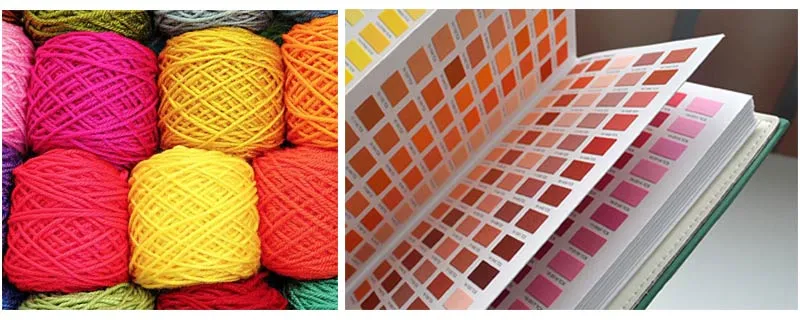Capítulo 3. ¿Cuáles son los materiales más populares de los suéteres navideños feos personalizados?
![]()
Sin duda, los 4 materiales más populares para los suéteres navideños feos son: Acrílico, Algodón, Algodón / Acrílico, ¡Poliéster! La expresión técnica completa es: 2/28 100% acrílico, 2/30 100% algodón, 2/28 45% algodón 55% acrílico, 2/30 100% poliéster.
Acrílico, material número uno utilizado en los suéteres navideños. ¡Es cálido y fácil de tratar!
- Acrylic fiber has the reputation of synthetic wool, and its elasticity and fluffy degree are similar to natural wool. Therefore, the warmth retention of the fabric is not lower than that of wool fabric, even 15% higher than that of similar wool fabrics.
- Acrylic fabric is brightly dyed and has the best light resistance. Pretty suitable for colorful designs of Christmas Sweaters;
- Acrylic fabric is good at dimensional stability.
- Acrylic fabric has good heat resistance, second to synthetic fiber, and is resistant to acid, oxidant and organic solvent, and relatively sensitive to alkali.
- Acrylic fabric is the lighter fabric in the synthetic fabric, so it is a good to lower the weight of Christmas sweaters, which produce lower cost of whole sweaters
¡Contáctenos para obtener un libro de color acrílico con 354 colores!
Algodón, hilo N ° 2 para suéteres navideños feos.
- Hygroscopicity. Cotton fiber has good moisture absorption. Under normal circumstances, the fiber can absorb water into the surrounding atmosphere, with water content of 8-10%, so it contacts the skin of human, making people feel soft but not stiff. If the humidity of cotton increases, the surrounding temperature is higher, the moisture in the fiber will evaporate and completely disperse, so that the fabric can keep water balance and make people feel comfortable.
- Moisturizing. Cotton fiber is a bad conductor of heat and electricity, and its thermal conductivity is very low. Because of the advantages of porous and high elasticity, a large amount of air can be accumulated between the fibers, and air is also a bad conductor of heat and electricity. Therefore, cotton fiber textiles have good moisture retention, and people will feel warm when they wear pure cotton clothing.
- Heat resistance. Pure cotton fabric has good heat resistance, Therefore, the pure cotton fabric is used at room temperature, and it has no influence on the fabric when it is washed and dyed, thus improving the washability and wearing performance of the pure cotton fabric.
- Alkali resistant. Cotton fiber has strong alkali resistance. Cotton fiber in alkali solution, the fiber will not be damaged. This characteristic is beneficial to cleaning pollution, disinfection and impurity removal after taking. At the same time, cotton textiles can be dyed, printed and processed by various processes, and more new cotton varieties can be produced.
¡Contáctenos para obtener un libro de colores de algodón con 342 colores!
Mezcla de algodón / acrílico (2/28 45% algodón 55% acrílico), hilo N ° 3 para suéteres navideños feos.
- Acrylic cotton fabric has wool like color and warmth retention, beautiful appearance and high-end atmosphere.
- Acrylic cotton fabric has good elasticity and elastic recovery performance, and the fabric has good shape retention.
- Acrylic cotton fabric has excellent acid resistance and chemical resistance.
- Acrylic cotton fabric has the skin affinity, moisture absorption and air permeability of cotton fabric, which makes the fabric comfortable and beautiful.
- Acrylic cotton fabric has high strength, strong heat resistance and light resistance.
¡Contáctenos para obtener un libro de color acrílico de algodón con 377 colores!
Poliéster, hilo N ° 4 para suéteres navideños feos.
El poliéster también se llama fibra similar al algodón, esto se debe a que el poliéster se ha actualizado durante muchas generaciones, ahora tiene una apariencia y una sensación similares al algodón. No es tan rígido y de baja calidad como lo que imaginamos. Mientras tanto, el poliéster tiene las ventajas del algodón y del poliéster. Tiene las ventajas de suavidad, calidez, conducción de humedad, sequedad, saneamiento y antibacteriano.
- Very good wear resistance. The advantages of polyester fabric are durability, wrinkle resistance, no iron, no deformation and good performance;
Good thermoplasticity. It is the most heat-resistant fabric in the synthetic fabric. It has high strength and elastic recovery ability. It is firm and durable.
- It is not afraid of mold and insects;
- It has good light resistance and better light resistance than natural fiber fabric;
¡Contáctenos para obtener un libro de colores de algodón como poliéster con 90 colores!
Para clasificar arriba los 4 materiales más populares para los suéteres navideños, digamos:
- Chain store for adult, suggest acrylic;
- Chain store for kids, suggest cotton;
- High quality labels, suggest cotton/acrylic for adults, pure cotton for kids. Or pure cotton for all, as cost for both yarn are very similar.
- Promotional use, suggest polyester.
Los costos de los 4 materiales más populares para los suéteres navideños, digamos:
Algodón puro> 45% algodón 55% acrílico> Acrílico> Poliéster [basado en exactamente el mismo diseño]
Hice un ejemplo con una idea de costo para una referencia más fácil:
Diseño básico para hombres-12gg
Acerca de FOB Shanghai USD7 ~ USD7.5 / pc base en 1000 piezas
Acerca de FOB Shanghai USD6.9 ~ USD7.4 / pc base en 1000 piezas
Acerca de FOB Shanghai USD6.5 ~ USD7.0 / pc base en 1000 piezas
Acerca de FOB Shanghai USD6.3 ~ USD6.8 / pc base en 1000 piezas
